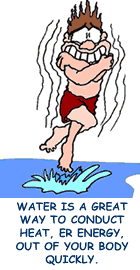|
|
Kinetic Energy is Matter in Motion
Kinetic energy is the energy contained in a moving mass or in a moving particle (a particle is a tiny bit of matter). I think it might be fun to call this "happening energy" (hoping I don't get in trouble with any teachers). If you could look close enough, or small enough, you would see that when anything is "happening", work is being done, or has been done, and something (mass), or a whole lot of little "somethings", are moving.
So this page is the nit-picky page. Here is where those of us that want to really "get it straight" - or really get confused - can come to ponder and argue, and hopefully understand a little more about energy.
Read on, McDuff....
Work and Heat are Processes (and Forms of Energy?)
 There are just two ways that energy is transferred - by work or by heat. We often use the words work and heat as if they are forms of energy. I do it all the time and I'm not sorry. But some thermodynamic text books say that work and heat are processes or methods of energy transfer, not forms of energy. There are just two ways that energy is transferred - by work or by heat. We often use the words work and heat as if they are forms of energy. I do it all the time and I'm not sorry. But some thermodynamic text books say that work and heat are processes or methods of energy transfer, not forms of energy.
When describing energy transfers in this way, we should say something like, "energy transferred during a work process". Or when talking about a heat process, we would be more correct to say, "energy transferred by heat flow". Most of us don't because it gets old fast. But that would be the clearer way to refer to those two processes.
Really. Think about it for a bit. It is energy that is transferred or changed. The process by which this occurs is either by work or by heat (not by hook or by crook). In this context, they are processes or methods of energy change, not types of energy.
An example:
A man is floating in water after falling out of a boat. He is wearing a life jacket, of course. Anyone who goes boating without a life jacket is a fool. The water temperature is 0 degC (32 degF). Because the water temperature is much lower than the man's body temperature of 38 degC (98.6 degF), and because water is such a good conductor for heat flow, energy as heat will flow rapidly from his body into the water. In just a few miserable minutes the man's body temperature will start to drop, and the water around him will be warmed up a little bit. Energy is being transferred, by the process of heat flow, from his body to the surrounding water. It was internal energy that was transferred, not heat. We usually say he is losing heat. But what he is really losing is internal energy. Internal energy is the word that is more correctly used in thermodynamics to describe the microscopic forces and movements that are often called heat.
(Note: see new comments on the term "thermal energy" below)
Heat is Work when Things are Teesy-Weensy
But that's not all. Our nit-pickiness has just begun. To be really nit-picky, we have to realize that down on the teensy-weensy scale ("microscopic or atomic" scale, if you must be formal), heat is work. Yup, the concept of heat is sort of an illusion resulting from our hugeness of size and the impossibility of keeping track of unimaginably large numbers of unimaginably small atoms and molecules.
What we call heat flow is really the average result of trillions of atoms and molecules transferring their kinetic energy, through the work process, to other atoms and molecules. |
|
|
"...heat and internal energy are two quite different things; the energy associated with microscopic motions and forces is internal energy, not heat."
from Thermo text book:
Engineering Thermodynamics
by William Reynolds and Henry Perkins
McGraw-Hill Book Company
"See, I told you so."
from small minded know-it-all author David Watson |
|
 |
 |
 |
 |
 |
Whenever energy is transferred through a work process, kinetic energy is involved. Energy is transferred by work to an object or system when a force is exerted through a distance on that object or system. For a force to travel through a distance there has to be movement. Something has to move and push against something else. That something else that is pushed on is then also moved. If nothing moves, no work is done, and no energy is transferred. Anytime a small or large chunk of matter is moving it contains kinetic energy.
In hot water, or your body, or a shrew's body, or a whale's body, or a mosquito's body, or in the air they all breathe, or the rocks they sit on (except for whales), molecules and atoms are spinning, vibrating, binding together with nuclear forces, storing energy as mass according to Einstein' equation, transferring electrons, or in the case of a gas, just generally flying around and banging into each other. When these tiny bits of matter bang into each other, or transfer electrons or electromagnetic energy, or vibrate or spin against each other, they transfer energy by doing work on each other. Yup, work is being done, one tiny atomic particle at a time.
I'll say it again. Because they are so really really (two really's) small, and because there are many trillions of them, and because things happen so fast, we cannot even begin to think about measuring the energy of each atomic particle. However, we can measure some things that indicate the average energy of all of them combined. When we measure temperature or pressure we are measuring the average energy of all of the atoms and molecules.
In fact temperature in a gas is often described (not defined!) as the average kinetic energy of all the atoms and molecules in the gas.
Pressure is a force acting on a certain area. Pressure in a gas like air, or a liquid like water, is the average force of trillions of atoms and/or molecules pushing on a certain area. We measure pressure in units like Newtons of force per square meter (called Pascals) or pounds of force per square inch (psi). The higher the average "pushing" energy of all the microscopic particles, the higher the pressure.
If the temperature of the air in your house goes up, it is because the average kinetic energy of the air molecules in your house has increased. At any given moment some molecules are going fast and some are going slow. Some are banging into others, transferring energy by work from one to another. But the average energy of all of them combined has increased. If you start to feel hot, it is because the higher energy air molecules have started to transfer more of this energy by the mechanism of heat flow into the molecules of your body, and less internal energy, created by your metabolism, is able to flow out of your body.
 |
|
 |
There are Two Types of Energy - in Many Forms
Despite all my nit-picking in the words above, most scientists and engineers find it acceptable and useful to talk about chemical and electrical and mechanical and magnetic energy and others. They also frequently describe internal energy as heat or "heat content" or "quantity of heat" as some of the older texts call it.
But it is helpful to understand why some people say that all those other forms of energy are really types of kinetic energy or potential energy being "expressed" in different ways.
Electrical energy, for example, is the flow of charged particles called electrons or ions. When electrons are flowing through a wire or through hundreds of feet of air (an event we call lightning) it is because they are being "pushed" or forced by an electrical field. This field is caused by a difference in electrical charge. A force is exerted on the electrons and they move. Work is done on the charged particles. A force is pushing them through a distance. Actually, they are hopping from atom to atom, being pushed by an electromotive force. While the electrons are moving they contain kinetic energy. So at the itsy-bitsy atomic level electricity is a form of kinetic energy.
Mechanical energy is the useful way we sometimes refer to things like gears, engines, locomotives pulling trains, canon balls flying through the air, or other examples of energy in mechanical devices. But, of course, by now you see that all these moving parts contain kinetic energy. They are really just different modes of kinetic energy - the energy contained in a moving mass. In order to get these various objects spinning or rolling, a force has to be exerted. Work is a force acting through a distance, so the way they get moving and keep moving is by having work done on them. Work is an energy transfer process.
Chemical energy is another term we use a lot. This is more vague. We say things like, "during combustion, chemical energy is released". Hmmm. The term chemical energy refers to energy that is stored in molecular bonds, the forces that hold molecules together. So releasing chemical energy must mean the energy is finally free from its molecular bonds. In the more general sense, of course, it is potential energy. Stored energy, or energy that is "waiting to happen", or that has the "potential" to happen, or that can happen but hasn't yet, is rather sensibly called potential energy.
As described in the photosynthesis section, carbohydrate molecules, used by living organisms for food (and other things), store energy in their atomic bonds. Living cells release this stored energy relatively slowly by a process called respiration. Some of the stored potential energy becomes the kinetic energy of cell processes and muscle movement and some of it becomes internal energy (often called heat). But now you know I should have said, "some of stored energy is transferred by the heat process into the internal energy of the cell. The cell is "warmed up" by increasing the average energy of the cell molecules. Eventually, of course, all of it becomes internal energy and then flows by heat transfer into the air and objects around the organism.
Enough examples. We get the idea. Maybe you can think about some other forms. Unless you are writing a thermodynamics text book it is probably okay to say there are more than two forms of energy and to use the terms heat and work as if they are a type of energy. So when you find me doing it in this web site, don't write me a nit-picky e-mail telling me heat is a process, not a form of energy. I know. I know.
Thermal Energy (side note added later)
Bopping around in various text books and resources is the fairly common term "thermal energy". This seems generally to be used as another term for internal energy or heat content. One of my thermo books does outright propose this term as a way to avoid using heat as a type of energy. According to this book, it was tried in the past but never quite caught on. I still like the idea, and so have started using the term interchangeably in new pages on this site. So in this web site when you see the term thermal energy it means the type of internal energy that is usually called heat as described above. It the short run it may add to your confusion, but in the long run you'll be the wiser for it. Do you buy that?
Back
|
|
|
|
|
|
|
|
|
|
Written by David Watson
Comments |
|
|
|
|
If this page was helpful, please recommend it for others:

|
|
|
|
|
|
Top of Page |
|
|
|
|
|
|
|
|
|
| ©Copyright 2010, 2014, David E. Watson. All rights reserved. Everything in the Flying Turtle web site is copyrighted. For information concerning use of this material, click on the word Copyright. |
|
|
|
|
|
|
|
|
 |
 |
 |
 |
 |
|
|
The LINKS above and below are NOT paid ads.
They are part of my
ACh Lift projects and interests.
Enjoy them:

Visit my porch
If this page was helpful,
please recommend:

|





